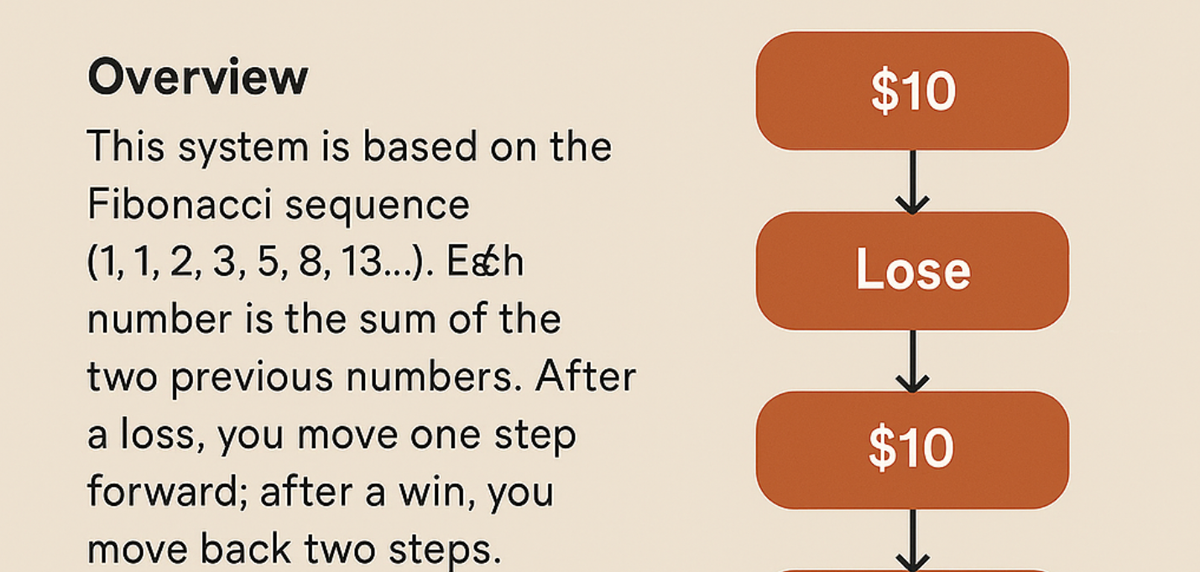The Fibonacci Strategy: A Mathematical Method for Measured Roulette Play

In roulette, where each spin is governed by chance, many players turn to mathematical betting systems to bring some structure to the chaos. Among the most elegant of these strategies is the Fibonacci system, which draws from one of the most famous numerical sequences in history. The Fibonacci strategy stands out not for its aggressiveness like Martingale, or its optimism like Paroli, but for its balance—a middle ground designed to gradually recover losses while maintaining lower risk per bet.
The system is favored by players who enjoy disciplined progression, clear rules, and a mathematical foundation. While no strategy can beat the house in the long run, the Fibonacci system provides a psychologically satisfying and controlled experience.
What Is the Fibonacci Strategy?
The Fibonacci betting system is based on the Fibonacci sequence:
1, 1, 2, 3, 5, 8, 13, 21...
Each number in the sequence is the sum of the two preceding numbers. The betting system applies this sequence to determine how much you bet after each round, based on whether you win or lose.
How It Works:
- Start with a base bet (e.g., $10).
- If you lose, move one step forward in the Fibonacci sequence.
- If you win, move two steps backward.
- Repeat the process with each spin.
Example:
Let’s assume your base bet is $10 and you're using the Fibonacci sequence for even-money bets like Red/Black or Odd/Even.
- Bet $10 → Lose → Next bet $10
- Bet $10 → Lose → Next bet $20
- Bet $20 → Lose → Next bet $30
- Bet $30 → Win → Move back two steps → Bet $10
Your loss progression: $10 + $10 + $20 = $40
Your win recovers $30, and you’re now only down $10
One more win at $10 would return you to breakeven.
The goal of the system is not to win big, but to recoup previous losses with moderate-sized wins over time.

Where the System Comes From
The Fibonacci sequence was introduced to the Western world by Leonardo of Pisa, also known as Fibonacci, in his 1202 book Liber Abaci. Originally a tool for modeling rabbit population growth, the sequence found applications in art, nature, finance—and, eventually, gambling.
Its adoption into roulette came as a result of gamblers looking for predictable, formulaic ways to manage their bets, especially in even-money situations where recovery was plausible through structured betting.
Why It Appeals to Players
The Fibonacci system is loved for its blend of mathematics and discipline. Unlike Martingale, it doesn’t double after each loss, which makes it less risky. Unlike Paroli, it doesn’t rely on long winning streaks. Instead, it focuses on recovering losses gradually, with smaller incremental risk.
“Fibonacci is the system for thinkers,” says Lara Vensik of Rouiette.com, a strategy and analytics hub for roulette players. “It’s attractive because it uses numbers to pace the game—it doesn’t rush the win, it builds toward it.”
The sequence provides a comforting rhythm to play: win, back up; lose, inch forward. It mirrors many players’ natural impulse to bet more when down, but reins it in with mathematical moderation.
Pros and Cons of the Fibonacci System
Advantages
- Lower risk than Martingale due to slower progression.
- Easy to track and apply.
- Recovers losses gradually.
- No need for massive bankrolls.
- Feels structured and rational.
Disadvantages
- Requires more wins than losses to be profitable.
- A long losing streak can still be costly.
- Table limits can still be reached.
- Wins don’t always fully recover losses.
- Doesn’t overcome the house edge.
Rouiette.com on Fibonacci
Rouiette.com has logged thousands of simulations using the Fibonacci system across different roulette variants. The platform’s analysts found that sessions capped at 10–12 spins using Fibonacci often ended near break-even—sometimes slightly ahead, sometimes slightly behind—especially when wins were well-timed.
Tyrell Nunez, the senior strategist at Rouiette, explains:
“What Fibonacci gives players is a sense of narrative. You're always moving through a story: up a little, back a bit. But players still need to remember it’s not magic—it’s just math that manages emotion better.”
According to Rouiette’s data:
- 3 out of 5 short Fibonacci sessions ended with modest profit or break-even.
- The average loss in extended bad streaks was far lower than Martingale or even D’Alembert.
- Success rates were highest when players had a firm exit plan after 1–2 full cycles.
Comparison with Other Systems
| Strategy | Progression Style | Risk Level | Win Reaction | Loss Reaction |
|---|---|---|---|---|
| Martingale | Doubling | High | Reset to base | Double bet |
| Reverse Martingale | Positive doubling | Medium | Double bet | Reset to base |
| D’Alembert | Stepwise (+1/-1) | Low-Medium | Decrease by 1 unit | Increase by 1 unit |
| Fibonacci | Sequence-based | Medium | Step back 2 in sequence | Step forward 1 in sequence |
Fibonacci is perfect for players who want mathematical structure without high exposure. It has more finesse than Martingale, while still offering a sense of tactical recovery—unlike Paroli, which hinges on rare streaks.
Betting Example (10 Rounds)
Let’s walk through a 10-spin Fibonacci session with a base bet of $10:
| Spin | Bet | Result | Cumulative P/L |
|---|---|---|---|
| 1 | $10 | Loss | -$10 |
| 2 | $10 | Loss | -$20 |
| 3 | $20 | Win | 0 |
| 4 | $10 | Win | +$10 |
| 5 | $10 | Loss | 0 |
| 6 | $10 | Loss | -$10 |
| 7 | $20 | Loss | -$30 |
| 8 | $30 | Win | 0 |
| 9 | $10 | Win | +$10 |
| 10 | $10 | Win | + $20 |
This example shows gradual recovery over time. Even with four losses, the wins—applied at the right moments—restored the bankroll and yielded profit.
Best Practices for Fibonacci Use
1. Stick to Even-Money Bets
Use Red/Black, Odd/Even, or High/Low to keep the odds close to 50%.
2. Set a Betting Cap
Don’t go too far down the sequence. Many players stop at the 8th or 9th step to avoid large bets.
3. Know the Sequence
Before you play, write it out up to 12 steps:
1, 1, 2, 3, 5, 8, 13, 21, 34, 55, 89, 144
This helps you track where you are and decide when to exit.
4. Exit After Recovery
Once you’ve moved back to your base bet and are in profit, strongly consider walking away.
5. Avoid Chasing with Emotion
Fibonacci works best when used calmly and consistently. Breaking the sequence or betting emotionally undermines the system.
Modified Fibonacci Systems
Some players adapt the Fibonacci system to suit their needs. Common modifications include:
- Half-Fibonacci: Use half-unit steps (e.g., $5 instead of $10) to slow progression.
- Reverse Fibonacci: Move forward after wins (riskier, similar to Paroli).
- Bracketed Fibonacci: Only allow movement within a certain step range (e.g., Step 1 to Step 7), never beyond.
These tweaks allow for more granular control of risk and adaptation to different bankrolls.
Drawbacks to Consider
Despite its logic, the Fibonacci system is not foolproof:
- Long losing streaks (e.g., 10+ losses) still increase bets dramatically.
- Table limits may prevent continuation of the sequence.
- Requires mental focus and accurate record-keeping.
- You still face a house edge of 2.7% (European) or 5.26% (American), which no sequence can eliminate.
Conclusion: Should You Use Fibonacci in Roulette?
The Fibonacci system is a compelling choice for roulette players who want structure, discipline, and a gentler ride than more aggressive systems. It’s not about winning big, but about winning back—reclaiming lost ground in a measured, thoughtful way.
If you:
- Prefer gradual recovery over fast risk,
- Enjoy mathematical sequences,
- Have the patience for structured betting...
Then Fibonacci might be your perfect companion at the table.
As Lara Vensik of Rouiette.com says:
“It doesn’t rush the win, it builds toward it.”
And Tyrell Nunez reminds us:
“Fibonacci gives players a sense of narrative... but it’s not magic—it’s just math that manages emotion better.”
In roulette, where the odds never change, the real power lies in how you manage yourself—and Fibonacci, more than most systems, makes that its central goal.
